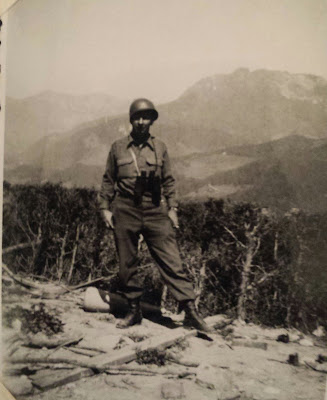"
Starnberg, Bavaria, Germany: June 20, 1945. Yesterday was a beautiful day, and I spent most of it driving. I saw a lot of scenery. I got some cherries off a cherry tree, and drove from 9 a.m. until 5 p.m. Last night, I went to a movie and watched some newsreels.
Today, I have had a very pleasant day. I got up at 5:45 a.m. and ate breakfast. Then eight of us got into a three-quarter ton truck headed for Hitler's summer resort "Berghof", which is about 200 miles from here. It took us three hours to get there. Most of the way from Munich, we went on the Autobahn highway, so we made good time. We were high up in the Austrian Alps, and they were covered with snow. The scenery was beautiful, with so many green trees, waterfalls, and blue lakes. All of the houses have large rocks on the roofs to hold them on. Then we went through a stone gateway, and we were in Berschtesgaden (name of the town where Hitler's home, Berghof, was located).
All of the buildings are made of stone. The whole resort is built on top of the mountains, hundreds of feet up. We parked the truck and started walking. The whole place had been bombed badly by the British and looted by the Allies. Most of the buildings were leveled to the ground.
Next we went into Goebbel's house. It's on a peak and the view is wonderful. Then we went through Hitler's house. It was huge, and had a very large recreation room and fireplace. There was a stage where shows were held. The one window in the room was about 25 feet by 40 feet. Then we went through other houses--a sun house and a bath house made of all glass. Everything was painted green and had artificial trees all over so the building wouldn't show from the air. But since tons of bombs were dropped on the place, nothing much was left.
Next we left the house and drove about four miles up. We went through four tunnels and some were so long we had to turn on the lights. The roadway and tunnels were also painted green with camouflage nets hanging over the tunnels. When we got up as far as we could, we got out and walked about a mile.
An elevator went up through the rock mountain and into the house on the lookout point. When we got to the top, there was a large rock lookout house. It had large rooms, a dining room with a table about 25 feet long. The lounge had big, soft rugs on the floor and a large fireplace. Every large window had a view of snow-covered mountains.
We started back and stopped along a river and made something to eat. We got back to Starnberg around 5:30 p.m. With all my love, Robert."
 |
| The Alps from Bertschesgaden |
 |
| Berghof, Bertschesgaden |
 |
| Hitler's House |
 |
| SS House |

















